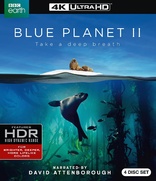Blue Planet II 4K Blu-ray Movie
HomeBlue Planet II 4K Blu-ray Movie 
4K Ultra HD + Blu-rayBBC | 2017 | 350 min | Not rated | Mar 06, 2018
Movie rating
8.3 | / 10 |
Blu-ray rating
| Users | 4.8 | |
| Reviewer | 4.5 | |
| Overall | 4.5 |
Overview
Blue Planet II 4K (2017)
Our understanding of ocean life has completely changed since The Blue Planet aired in 2001. Travelling from the icy polar seas to the vibrant blues of the coral atolls, Blue Planet II shares these astonishing new discoveries. Meet the strange octopuses lurking in the depths of the Antarctic ocean. Watch giant trevally fish leap to catch birds in mid-air. And ride on the back of a hammerhead shark as it attacks.
Starring: David AttenboroughNarrator: David Attenborough
| Documentary | 100% |
| Nature | 88% |
Specifications
Video
Video codec: HEVC / H.265
Video resolution: 4K (2160p)
Aspect ratio: 1.78:1
Original aspect ratio: 1.78:1
Audio
English: DTS-HD Master Audio 5.1
Subtitles
English SDH
Discs
Blu-ray Disc
Four-disc set (4 BDs)
4K Ultra HD
Packaging
Slipcover in original pressing
Playback
Region free
Review
Rating summary
| Movie | 4.5 | |
| Video | 4.0 | |
| Audio | 4.5 | |
| Extras | 2.0 | |
| Overall | 4.5 |
Blue Planet II 4K Blu-ray Movie Review
Reviewed by Martin Liebman August 12, 2018Prolific BBC Nature Narrator Sir David Attenborough (Life, Planet Earth) returns to the recording studio and the water to lend his vocal talents to the gorgeous, majestic, and captivating Blue Planet II, the follow-up to 2001's highly regarded The Blue Planet. While nature documentary fatigue feels like a very real thing in isolation, there's an organic, almost magnetic draw to these sorts of programs. The wonders of the world, which these days is described as "small," are really stretched quite far and wide and, in many cases in Blue Planet II, very deep. Great advances in technology have made not just witnessing, but experiencing, these wonders a much more intimate adventure. Gone are the days of simply aiming a camera at a creature; this film is on the cutting-edge of video capture technology, and the result is a breathtaking journey through the world's waters and visits with numerous creatures, large and small, recognizable and alien, and even if the film is structurally not all that different from its many predecessors, the magic materializes from the first minutes and the draw doesn't dissipate until the final fade on another first-rate exploration of this watery globe that is home to more than 7 billion people and certainly countless more numbers of exciting and diverse undersea creatures.

Blue Planet II's seven episodes originally aired on BBC between 29 October 2017 and 10 December of the same year. The program is focused yet diverse, revealing aquatic life with fascinating scientific insight and doing so by way of technological breakthroughs never before possible in bringing humans so close to nature's greatest undersea mysteries. From the warm tropics to the cold waters at the poles and throughout bodies of water of all sizes and temperatures and inhabited by countless creatures around the world, the program visits numerous creatures who live both near the surface and well below it. Creatures both majestic and almost microscopic are within the range of studied ocean dwellers. Blue Planet II focuses on various aquatic ecosystems and demonstrates how they are both stable and in many ways stagnant on a macro level and ever changing on a micro level as various creatures vie for control of a spot or a mate or disrupt the status quo in search of shelter or food or even play. The series reveals inter-species friendships and cooperations, disagreements, and the food chain. There is some focus on manís impact on the seas, notably in the final episode, but the program generally concentrates on the wild, wondrous, and even weird creatures who inhabit a world so alien yet so near to home.
Probably the most impressive takeaway from the program -- beyond the obvious sight and sound highlights and the seemingly personal exploration of each creature and every location -- is the practically seamless access. The program affords audiences the opportunity to not simply see sea creatures but to all but swim with them, to see as they see, to hear as they hear, to almost feel as they feel. Intimacy with these creatures and immersion into their world is presented at the peak of what currently available technology will allow, and while Attenboroughís narration is critical in shaping the story of whatís playing on screen, the larger, simpler narrative is effectively conveyed simply through sight, by the experience of witnessing, with unparalleled access, creatures and parts of the world that were before perhaps not unknown but never captured with this level of clarity and access to where and the way they live their lives. Blue Planet II is all but a personal invitation from the life that thrives throughout the program.
Itís impossible to watch the program and not consider the merging of nature and technology as it is seen here, the way that manís rapid forward movement is affording him opportunities just like this one to slow down, descend into the most mysterious depths on planet Earth, and discover nature at its most complex, mysterious, beautiful, and breathtaking. While the technology is rarely a prominent focus in the programís scene-to-scene unfolding, particularly through the first six episodes, itís nevertheless the unseen foundation. For all of the good -- and ill -- technology has left as its lasting, irremovable footprint on Earth, it is perhaps this program, and others like it, that might stand the test of time as a testament to the positive merging of nature, man, and his creations in bringing the best the world has to offer to anyone and everyone across this amazing globe, a globe with a surface predominantly covered by water that still to this day remains the greatest mystery on the planet. But year by year, film by film, and with every newly photographed drop of ocean water, manís knowledge of what lies beneath is becoming less obscured by inability and more explored by capability. Thatís why these programs remain fresh. With each one thereís always a newer, clearer, more intimate way of seeing the world.
Each episode runs around 50 minutes, and the final 10 or so are a "supplement" that explore some of the "making of" aspects of the episode, which is a nice treat coming directly off the show to reveal how so much of the previous 50 minutes' magic was made. Episode pacing is strong. The subject and even locations switch up every few minutes, and while there's occasionally a feel that the episodes are scattershot, jumping from place to place and creature to creature, the show holds together with a continuous, regular string of fascinating sights and fun creatures on display. And that the program explores more than just the sights but also the creatures' sounds, habits, relationships, feeding, and many other everyday aspects of their lives that rise above trivia and into the realm of the remarkable makes every transition a new, exhilarating, sometimes breathlessly anticipatory experience to see what the undersea world has to offer next. And the sense of scope, grandeur, the program's large-scale cinematic breadth makes for the perfect complimentary support to the narrative but also the ocean's vastness and the world's expansiveness.
The final episode of the seven, "Our Blue Planet," takes something of an about-face and explores some of the negative impacts man has made on the "blue planet." While the first six episodes are celebrations of life and, in a roundabout way man's ability to see and study it, the final hour takes the opportunity to provide a different spin on the evolving ecosystem. The dangers of plastics, dumped waste, and other manmade harms to the environment and the creatures that call it home play particularly powerfully juxtaposed against the previous six hours of breathtaking exploration of the bounties of natural ecosystems and the creatures who inhabit it. The segment additionally pays attention to those who are battling to conserve and preserve the ocean's life and better understand the relationship between man and those creatures who dwell under the sea.
Blue Planet II 4K Blu-ray Movie, Video Quality 

Blue Planet II was reportedly finished at 4K, and the resultant UHD presentation is a thing
of beauty, not quite perfect but vastly superior to the often very good, but sometimes troubled, Blu-ray. The most prominent quality of the entire UHD release is the great
increase in color depth and brilliance. The HDR encoding pushes the image forward a significant degree from the 1080p counterpart, presenting every
shade with noticeably more intensity, including blue waters, colorful creatures, and deep natural greens. The leap forward just in water, presenting here
in a
much more impressively dense, nuanced, and brilliant shade is worthy of the upgrade alone, but the improvements to subtle variations, the big add to
brightness, and the improvements to black level depth are all astonishing. Textural efficiency is much higher as well. Image clarity enjoys a major
boost to where both intimate creature shots and vast vistas above the ocean's surface dazzle with a newfound clearness well beyond the Blu-ray
format's capabilities. The image is a little glossy in 4K but it's sharp as a tack and, together with the improvements to color, Blue Planet II can
practically take one's breath away.
Beyond the adds to color and clarity, it's the more efficient encode and higher bitrates that help to significantly reduce, if not sometimes altogether
eliminate, some of the problem areas found on the Blu-ray, including excess banding and macroblocking. A few quick examples just from episode six.
As the episode begins, viewers see a large sea turtle on the ocean floor. On the Blu-ray, macroblocking is prominent. On the UHD, it's barely
noticeable, if at all. At the beginning of chapter two, there's a shot of the moon crossing through the night sky kicking off a segment on tides. The
banding on the Blu-ray is unbearable and while it's still present on the UHD, the effect is significantly reduced, perhaps as much as, if one wants to put
a rough estimate number on it, 90%. Throughout the program, the UHD's increased efficiency is a true saving grace, to keep visual distraction perhaps
not to an absolute minimum but reduced enough that such do not necessarily draw the eye when the focal point should rightly be elsewhere on the
screen. If the great increase in color and solid boost to textures were not enough, the bitrate and improved encode certainly should be.
Blue Planet II 4K Blu-ray Movie, Audio Quality 

Blue Planet II's DTS-HD Master Audio 5.1 lossless soundtrack is the same that appears on the Blu-ray disc. It's active and alive, bringing ocean waves, deep underwater bass, creature sounds, and other niceties to life with impressive stage saturation, across the front and through the rears as well. Even without the benefit of overhead channels, there is a very significant sense of top end rush to several key moments -- big waves, underwater depth -- and the stage often feels flooded as water splashes through with great force and greater clarity, even when accompanied by prodigious, stage-stretching and surround- intensive score. Musical clarity and low end accompaniment are just as satisfying as the natural and aquatic sounds. Narration presents without issue.
Blue Planet II 4K Blu-ray Movie, Special Features and Extras 

The only "supplements" on the three-disc Blu-ray version of this release were the ~10-minute making-ofs at the end of the first six episodes. These carry over here, just on a separate Blu-ray disc rather than added on to the programs in UHD. The upside is that they are included, the downside is they do not play immediately after the program and they remain in 1080p and SDR color rather than enjoy a boost to 2160p and HDR. On the UHD, the supplement is simply entitled The Making of 'Blue Planet II' (1080p, 51:37) which is, essentially, a behind-the-scenes exploration of the making of each episode. These segments explore the four-year journey behind making the movie: the project's purpose, the benefits of new diving and camera technologies, shooting treacheries (raging weather, leaking submersibles), deep ocean mysteries, and all of the moving parts necessary to bring the film together, shot by shot and segment by segment.
Blue Planet II 4K Blu-ray Movie, Overall Score and Recommendation 

Blue Planet II may not be a standout in terms of basic presentation and in its most basic depictions of all that it explores, but it's a strong step forward in terms of the intimacy and clarity with which modern technology can reveal a previously mysterious world. The imagery is striking, the creatures are fun and colorful and much more complex and intelligent than man might assume, and the film does well to depict its subjects well beyond mere snapshots and allowing the audience to become involved in their daily routines, all thanks to a magnificently large, grand sight and sound experience. BBC's UHD is spectacular. A little bit of banding, macroblocking, and noise appear, though all are greatly diminished compared to the Blu-ray. Color and details are absolutely exceptional; this is just the sort of program made for 4K, and it thrives on the UHD format. The 5.1 soundtrack is unchanged from the Blu-ray and the end-of-program supplements are carried over on their own Blu-ray disc. Blue Planet II's UHD release earns my highest recommendation.
Other editions
Blue Planet II: Other Seasons
Similar titles
Similar titles you might also like

Planet Earth II 4K
2016

Seven Worlds, One Planet 4K
2019

Dynasties 4K
2018

The Green Planet 4K
2022

A Perfect Planet 4K
2021

Frozen Planet II 4K
2022

Earth: One Amazing Day 4K
2017

The Blue Planet: Seas of Life
2001

Planet Earth III 4K
2023

Life
BBC / Narrated by David Attenborough
2009

Planet Earth
The Complete Series
2006

Frozen Planet
The Original UK Series
2011

A Beautiful Planet 4K
IMAX Enhanced
2016

Great White Shark 4K
2013

Human Planet: The Complete Series
BBC
2011

Oceans: Our Blue Planet 4K
2018

Sharks 3D
2004

Ocean Wonderland 3D
2003

Journey to the South Pacific 4K
IMAX Enhanced
2013

Tornado Alley 4K
2011




